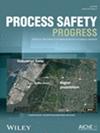采用 HAZOP、FMEA 和 FTA 组合方法识别整体式压水反应堆(IPWR)冷却系统的风险
IF 1
4区 工程技术
Q4 ENGINEERING, CHEMICAL
引用次数: 0
摘要
整体式压水堆(IPWR)由于初始资本投资较低、坐席灵活性高、固有安全性高,在印度尼西亚的应用越来越受到关注。IPWR 在很大程度上依赖于被动冷却系统,该系统有许多优点,但由于无人进行商业运营,因此缺乏运营经验。因此,有必要对运行过程中可能发生的被动冷却系统故障进行风险分析。即使单独使用传统的风险分析方法,其结果也存在缺陷。本研究旨在综合使用危险与可操作性分析 (HAZOP)、故障树分析 (FTA) 和故障模式与影响分析 (FMEA) 方法,以识别 IPWR 一级冷却系统在正常运行期间的风险。HAZOP 用于识别危险,FTA 分析关键问题的根本原因,而基本事件的 FMEA 则用于风险排序和缓解措施。这种综合方法使风险评估更加系统和全面,因为它可以管理整个实体的风险。研究结果为参与印度尼西亚核电厂(NPP)发展决策的利益相关者提供了宝贵的见解。本文章由计算机程序翻译,如有差异,请以英文原文为准。
Risk identification of integral pressurized water reactor (IPWR) cooling system using a combination HAZOP, FMEA, and FTA methods
Integral Pressurized Water Reactor (IPWR) is gaining attention for use in Indonesia due to lower initial capital investment, sitting flexibility, and high level of inherent safety. IPWR relies heavily on passive cooling systems that have many advantages but lacks operational experience because no one operates commercially. Therefore, it is necessary to carry out a risk analysis related to passive cooling system failures that may occur during operation. Even if conventional risk analysis methods are applied singularly, the results still have shortcomings. This study aims to integrate the use of the Hazard and Operability Analysis (HAZOP), Fault Tree Analysis (FTA), and Failure Mode and Effect Analysis (FMEA) methods to identify risks in the IPWR primary cooling system during normal operation. HAZOP was used to identify hazards, FTA analyzed the root causes of the critical problems, and the basic event's FMEA was developed for risk ranking and mitigation measures. This combined methodology makes risk assessment more systematic and comprehensive because it manages entity-wide risk. The results offer valuable insights for stakeholders involved in decision-making regarding the development of nuclear power plants (NPPs) in Indonesia.
求助全文
通过发布文献求助,成功后即可免费获取论文全文。
去求助
来源期刊

Process Safety Progress
工程技术-工程:化工
CiteScore
2.20
自引率
10.00%
发文量
99
审稿时长
6-12 weeks
期刊介绍:
Process Safety Progress covers process safety for engineering professionals. It addresses such topics as incident investigations/case histories, hazardous chemicals management, hazardous leaks prevention, risk assessment, process hazards evaluation, industrial hygiene, fire and explosion analysis, preventive maintenance, vapor cloud dispersion, and regulatory compliance, training, education, and other areas in process safety and loss prevention, including emerging concerns like plant and/or process security. Papers from the annual Loss Prevention Symposium and other AIChE safety conferences are automatically considered for publication, but unsolicited papers, particularly those addressing process safety issues in emerging technologies and industries are encouraged and evaluated equally.
 求助内容:
求助内容: 应助结果提醒方式:
应助结果提醒方式:


